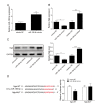Oleanolic Acid Inhibits Neuronal Pyroptosis in Ischaemic Stroke by Inhibiting miR-186-5p Expression
- PMID: 34983881
- PMCID: PMC8752321
- DOI: 10.5607/en21006
Oleanolic Acid Inhibits Neuronal Pyroptosis in Ischaemic Stroke by Inhibiting miR-186-5p Expression
Abstract
Ischaemic stroke is a common condition leading to human disability and death. Previous studies have shown that oleanolic acid (OA) ameliorates oxidative injury and cerebral ischaemic damage, and miR-186-5p is verified to be elevated in serum from ischaemic stroke patients. Herein, we investigated whether OA regulates miR-186-5p expression to control neuroglobin (Ngb) levels, thereby inhibiting neuronal pyroptosis in ischaemic stroke. Three concentrations of OA (0.5, 2, or 8 μM) were added to primary hippocampal neurons subjected to oxygen-glucose deprivation/reperfusion (OGD/R), a cell model of ischaemic stroke. We found that OA treatment markedly inhibited pyroptosis. qRT-PCR and western blot revealed that OA suppressed the expression of pyroptosis-associated genes. Furthermore, OA inhibited LDH and proinflammatory cytokine release. In addition, miR-186-5p was downregulated while Ngb was upregulated in OA-treated OGD/R neurons. MiR-186-5p knockdown repressed OGD/R-induced pyroptosis and suppressed LDH and inflammatory cytokine release. In addition, a dual luciferase reporter assay confirmed that miR-186-5p directly targeted Ngb. OA reduced miR-186-5p to regulate Ngb levels, thereby inhibiting pyroptosis in both OGD/R-treated neurons and MCAO mice. In conclusion, OA alleviates pyroptosis in vivo and in vitro by downregulating miR-186-5p and upregulating Ngb expression, which provides a novel theoretical basis illustrating that OA can be considered a drug for ischaemic stroke.
Keywords: Ischaemic stroke; Neuroglobin; Oleanolic acid; Pyroptosis; miR-186-5p.
Conflict of interest statement
The authors declare that there is no conflict of interest.
Figures








